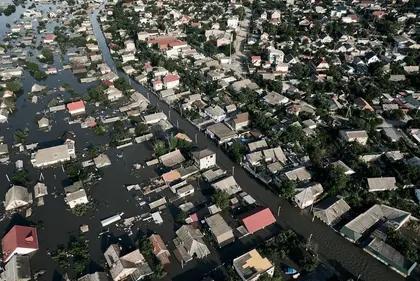In the early hours of Tuesday morning, June 6, an explosion at the Kakhovka Dam in Ukraine’s Kherson region caused it to collapse which, over the next few days, will release most of the 18 cubic kilometers of water held in its adjacent reservoir. Ukraine’s Emergency Situations Ministry said the initial water release created a wave 4.8 meters high and 5 kilometers wide, moving at 24 kilometers an hour, sweeping all before it, flooding and destroying homes and villages along a 90-kilometer stretch of the Dnieper River.
- Obtain the most recent updates on the Ukraine situation today.
- Read the newest Ukraine news stories published today.
This immediate disaster will soon be followed by severe environmental consequences throughout the area and, what is predicted to be, a widespread shortage of drinking water that will affect the southern regions of Ukraine, including the temporarily occupied Crimean Peninsula. Experts fear the situation will be cataclysmic, causing significant damage not only to water resources but also the natural reserves, biodiversity, soil, and forests within the region.
JOIN US ON TELEGRAM
Follow our coverage of the war on the @Kyivpost_official.
According to Ruslan Strilets, the Minister of Environmental Protection and Natural Resources, approximately 150 tonnes of oil have already entered the Dnipro River from damaged machinery within the dam, with the potential for further leakage of over 300 tonnes. The estimated damage to water resources alone amounts to around Hr. 2 billion.
The minister also highlighted the risk of flooding for 80 towns in the Kherson region. The Nizhnedniprovsky National Nature Park, covering more than 80,000 hectares of protected land with rare species, is at risk of permanent disappearance.

ISW Russian Offensive Campaign Assessment, January 20, 2025
Furthermore, agricultural crops in the Kherson, Zaporizhzhia, and Dnipro regions not only face immediate destruction but long-term devastation as the region relied on water from the Kakhovka reservoir for irrigation during annual summer droughts.
Yury Bolokhovets, the acting director general of the State Enterprise "Forests of Ukraine," reported that approximately 55,000 hectares of forest in the Kherson region have been flooded, as a result of the Kakhovka HPP explosion, which will lead to a significant loss of wildlife in the area.
Mykhailo Khorev, former deputy minister of environmental protection and natural resources of Ukraine, told Kyiv Post that the level of ecological damage would depend on how much water remains in the Khakovska reservoir.
“It is difficult to predict how low the water level will go, but the less water that remains in the reservoir, the worse it will be for the ecosystem. The bottom [of the reservoir] will become dry land, and all the organisms that live there will die,” Khorev said.
Physical damage caused by the initial flood poses additional risks to agriculture producers positioned close to the dam. The irrigation canals, which were constructed and designed to channel specific water content from the Dnipro, will not function as intended, causing problems for the future provision of water to the farms.
“Almost the entire territory there is functioning due to active irrigation. There are 400 thousand hectares of functioning systems,” Khorev said.
According to him, the irrigation systems will be dry and empty, and it will cause a huge problem for irrigated farming in the south of Kherson region in the future.
There are concerns about a potential shortage of drinking water, especially in the Kherson region. Ukraine is already making plans to urgently restore the water supply, with the government allocating funds to extend the water pipeline network to the area.
“The water intake facilities are located on the territory of the Kakhovsky reservoir, so it will have to be extended somehow. I noticed yesterday the government's decision to allocate half a billion hryvnias for the restoration of water pipelines to the new facility, if this situation occurs,” Khorev added.
Yevhen Khlobystov, an ecologist and professor at the Kyiv Mohyla Academy, commented to Suspilne TV that the dam's destruction would cause water supply problems for residents of those parts of the Kherson region, where the supply sources were connected to the Kakhovka storage facility:
"In my opinion, the problem with the water supply will be solved to some extent because it is still not such a large number of people. ... This will be a problem in the coming weeks because no one can instantly switch to another source of water supply."
Crimea, however, faces a more significant challenge as the loss of the Kakhovka HPP will leave the peninsula without any adequate fresh water. The dam ensured the water level in the Dnipro reservoir was maintained, which was crucial for filling the North Crimean Canal. Without water, the canal will cease to supply fresh water to the peninsula.
The self-proclaimed 'head' of Crimea, Sergey Aksyonov, has expressed concerns that a significant drop in water levels has already been observed in the canal. While the problem of water supply may be manageable in other regions of Ukraine, Crimea will face serious difficulties as no immediate alternative source of water supply is available there.
You can also highlight the text and press Ctrl + Enter










